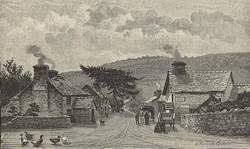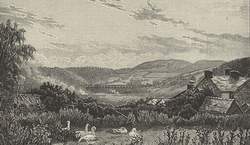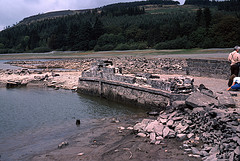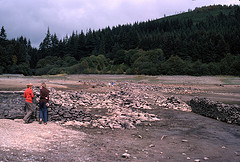Abandoned Communities ..... Reservoirs of Wales
Much information about life in Llanwddyn before its destruction has come from a commonplace book kept by David Jones. David Jones became a police constable in the village in 1881, appointed to a new post created in anticipation of the influx of workers occupied in the building of the dam. His commonplace book is not a contemporary account, but was compiled from his recollections some thirty years later.
David Jones' commonplace book is held in the Powys County Archives at Llandrindod Wells. Large parts of its contents, however, have been reproduced and discussed in a booklet by David W L Rowlands called "The Policeman's Story", available from the Tourist Information Office at Lake Vyrnwy.
David Jones describes the village and the surrounding countryside. He recalls, for example, the "distant sound of the Ceunant-y-Pistyll waterfall that often rang in our ears from the cleft, sliding down the rock, through sun and shadow to pay its tribute to the river". He provides individual portraits of several of the people living in Llanwddyn, including:
- Siôn Fawr, otherwise known as John Evans. Siôn Fawr was a powerful man, well over six feet tall. He was much in demand by the owners of cattle about to be driven to south eastern England as he had a unique technique for gripping the horns of a young ox and throwing it on to its back into a position where iron shoes could be applied to it. He was able to toss and wave the flag of the local band with unusual panache, and he held the record for throwing a round stone weighing 75 pounds.
- Erasmus Owen. In the absence of a resident doctor or nurse in Llanwddyn Erasmus Owen, whose main job was village blacksmith, provided an important service when people were ill or injured. He could offer treatment for accidents, burns and scalds, sprains, bleeding of arteries or veins, and fractures. According to David Jones "the people had every faith in his prescriptions and pharmacopoeias".
- John Griffiths, otherwise known as "the cripple". John Griffiths was physically disabled, unable to walk but able to get himself around by using two wooden pattens with iron rings on their base. He "was always in a good temper and full of simple wit, and very thankful for every little kindness shown to him."
After the initial petition opposition to the dam seems to have petered out. The villagers turned their attention to making sure that they gained adequate compensation for the loss of their homes. The owner of the land around Llanwddyn, the Third Earl of Powis, agreed to grant each tenant a 21 year lease. Such a lease meant that each householder would be entitled to compensation from Liverpool corporation. In addition the corporation was obliged to provide alternative accommodation for "persons belonging to the labouring classes" who lived in any house that had to be acquired by the corporation.
Local people also realised that the coming of the dam would bring other economic benefits, at least during the period of its construction. Apart from opportunities of employment, they made money from the workers on the project. They could offer accommodation, and a large proportion of the workers' weekly wages was spent in the local shops and pubs. As Saturday was payday the Crossed Guns, the Talybont, and the Powis Arms did particularly good business that night of the week.
The Liverpool Corporation Waterworks Act was passed by parliament on 6 August 1880, and work began soon afterwards. By November 1888 the dam was completed, at that time the largest masonry dam in Britain. The valves in the dam were closed and as Lake Vyrnwy started to form the last few residents moved out. On 23 November 1889 the water flowed over the summit of the dam for the first time. The aqueduct was completed and water began to flow to Liverpool on 14 July 1892.
An issue that arose during the construction of several Welsh dams was whether to leave the remains of dead people where they were or to exhume them and re-inter them above the water line. At Llanwddyn it was decided at an early date that re-interment would take place, and a new graveyard was opened not far from the eastern end of the dam. In a process that took over three years the old churchyard and the floor of the church itself were dug up from a depth of seven feet, and all human remains were gathered and transferred to the new cemetery. In his commonplace book David Jones noted that among the recorded burials the surname Evans occurred most often (82 times), with Jones, Davies, Owen, Morgan, Hughes, Gittins, Erasmus, and Griffiths also well represented.
On 23 February 1889, when the lake had partially filled with water, the Illustrated London News published a long article about Lake Vyrnwy. The article begins by proclaiming that "one of the grandest works of modern times … is now approaching its successful consummation". The article contains much fascinating information about the construction of the dam and aqueduct, and several illustrations. It predicts that the lake will become "a beautiful piece of scenery, which will attract visitors from all parts of the kingdom". It refers, however, in just half a sentence to the fact that an entire village, including "the dwellings of forty or fifty families", had to be demolished.
During exceptionally dry periods the water level of Lake Vyrnwy falls far enough that the remnants of the village of Llanwddyn appear. Two photographs taken in the summer of 1976 can be seen on the left.
David Jones' commonplace book is held in the Powys County Archives at Llandrindod Wells. Large parts of its contents, however, have been reproduced and discussed in a booklet by David W L Rowlands called "The Policeman's Story", available from the Tourist Information Office at Lake Vyrnwy.
David Jones describes the village and the surrounding countryside. He recalls, for example, the "distant sound of the Ceunant-
-
-
-
After the initial petition opposition to the dam seems to have petered out. The villagers turned their attention to making sure that they gained adequate compensation for the loss of their homes. The owner of the land around Llanwddyn, the Third Earl of Powis, agreed to grant each tenant a 21 year lease. Such a lease meant that each householder would be entitled to compensation from Liverpool corporation. In addition the corporation was obliged to provide alternative accommodation for "persons belonging to the labouring classes" who lived in any house that had to be acquired by the corporation.
Local people also realised that the coming of the dam would bring other economic benefits, at least during the period of its construction. Apart from opportunities of employment, they made money from the workers on the project. They could offer accommodation, and a large proportion of the workers' weekly wages was spent in the local shops and pubs. As Saturday was payday the Crossed Guns, the Talybont, and the Powis Arms did particularly good business that night of the week.
The Liverpool Corporation Waterworks Act was passed by parliament on 6 August 1880, and work began soon afterwards. By November 1888 the dam was completed, at that time the largest masonry dam in Britain. The valves in the dam were closed and as Lake Vyrnwy started to form the last few residents moved out. On 23 November 1889 the water flowed over the summit of the dam for the first time. The aqueduct was completed and water began to flow to Liverpool on 14 July 1892.
An issue that arose during the construction of several Welsh dams was whether to leave the remains of dead people where they were or to exhume them and re-
On 23 February 1889, when the lake had partially filled with water, the Illustrated London News published a long article about Lake Vyrnwy. The article begins by proclaiming that "one of the grandest works of modern times … is now approaching its successful consummation". The article contains much fascinating information about the construction of the dam and aqueduct, and several illustrations. It predicts that the lake will become "a beautiful piece of scenery, which will attract visitors from all parts of the kingdom". It refers, however, in just half a sentence to the fact that an entire village, including "the dwellings of forty or fifty families", had to be demolished.
During exceptionally dry periods the water level of Lake Vyrnwy falls far enough that the remnants of the village of Llanwddyn appear. Two photographs taken in the summer of 1976 can be seen on the left.
Two
The post office and Crossed Guns Inn
The dam before the village was flooded
These two photographs, taken during the summer of 1976, show the remains of Llanwyddyn village. They have been supplied by Robert Hewitt.
More photos in this series can be seen on the Flickr website.



